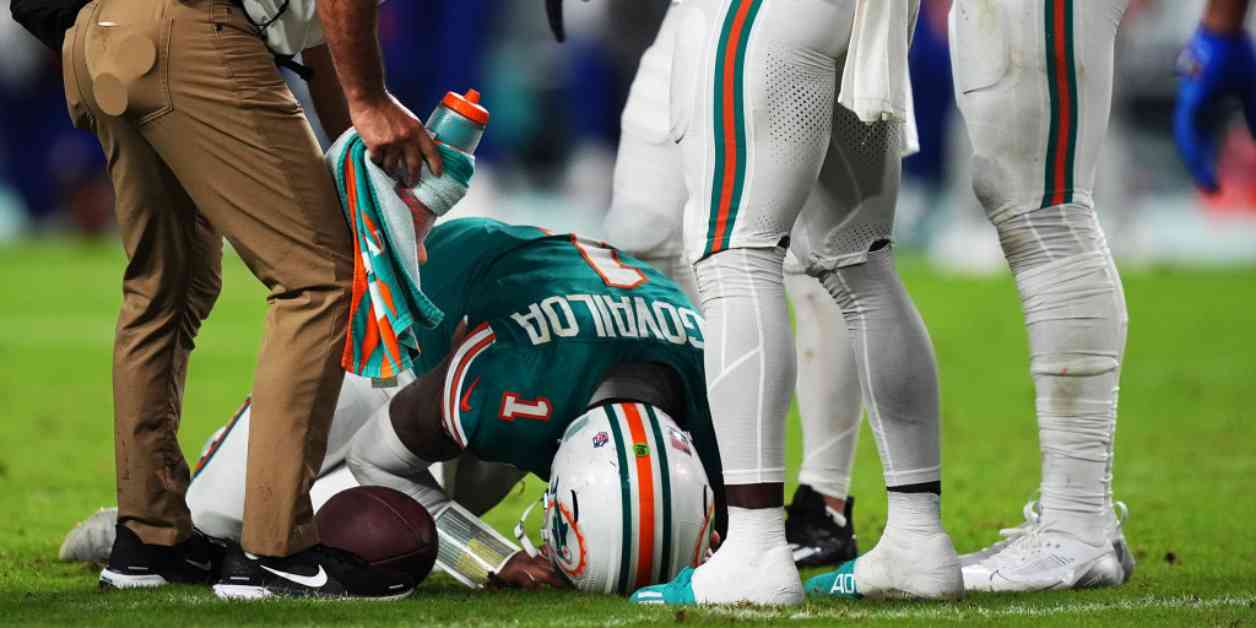When Miami Dolphins quarterback Tua Tagovailoa collided headfirst with Buffalo Bills safety Damar Hamlin during Thursday night’s football game, it was immediately evident to medical experts that Tagovailoa had suffered a serious concussion. As Tagovailoa lay on the field with his right arm extended and fingers curled in the fencing position, it marked the third diagnosed concussion of his NFL career following two back-to-back concussions in 2022.
Experts in the field of sports medicine and neuroscience have long warned about the dangers of multiple concussions and their impact on long-term health. Repeated head injuries, such as concussions, have been linked to an increased risk of developing chronic traumatic encephalopathy (CTE), a degenerative brain disorder associated with changes in mood, behavior, and cognition. While CTE has been diagnosed in hundreds of NFL players posthumously, it remains a mystery as to why some individuals are more susceptible to developing such conditions than others.
Steve Rowson, an associate professor of biomedical engineering at Virginia Tech and director of the Virginia Tech Helmet Lab, explained, “We know that repetitive concussions have been shown to be associated with an increased risk of cognitive impairment later in life. However, not everyone who experiences repetitive concussions develops brain health problems. Only a fraction of those individuals do, and we have yet to determine why certain individuals are more predisposed to long-term health issues following head injuries.”
Concussions are notoriously difficult to diagnose, often leading to many cases being overlooked or misclassified. Dr. Dan Daneshvar, chief of the division of brain injury rehabilitation at Harvard Medical School, emphasized the challenges of accurately diagnosing concussions, stating, “Concussions are defined as mild traumatic brain injuries resulting from a blow to the head or body that causes the brain to rattle back and forth, leading to symptoms such as double vision, confusion, trouble concentrating, and memory issues.”
The signs and symptoms of a concussion can vary widely, ranging from stumbling and vomiting to loss of consciousness in severe cases. It is essential for medical professionals to properly assess and diagnose concussions to mitigate the risk of long-term health consequences. In particular, the cumulative effect of multiple head injuries can be detrimental to brain health, as evidenced by research from the Boston University CTE Center and a study published in the journal Nature Communications.
Dan Daneshvar, the lead author of the aforementioned study, highlighted the importance of considering the total amount of head injury burden over an individual’s lifetime rather than focusing solely on the number of concussions sustained. He explained, “What we’re finding is that when it comes to the long-term problems associated with head injuries, it appears that the total amount of head injury burden accumulated throughout one’s life is a more significant determinant of outcomes than the number of concussions alone.”
The devastating impact of CTE on mental health has been tragically illustrated by the suicides of several former football players, including Junior Seau, Dave Duerson, Ray Easterling, and Aaron Hernandez, all of whom were posthumously diagnosed with the condition. The prevalence of CTE among former NFL players underscores the urgency of addressing the risks associated with repeated head injuries in contact sports.
While football and other contact sports are commonly associated with concussions, it is essential to recognize that concussions can result from various sources, including falls, car accidents, and bicycle crashes. Jay Alberts, director of the Cleveland Clinic Concussion Center, noted, “A single concussion is unlikely to cause major long-term effects unless there are underlying conditions or factors at play. However, research on former NFL players has shown a higher incidence of neurological diseases compared to the general population, raising concerns about the threshold for developing conditions like CTE.”
The case of Tua Tagovailoa, who has experienced multiple concussions in a relatively short span of time, has sparked debate within the NFL community about the risks and consequences of head injuries in professional sports. Following his most recent concussion, Tagovailoa faced calls to consider retiring from the game to prioritize his long-term health and well-being.
Antonio Pierce, head coach of the Las Vegas Raiders, expressed concern for Tagovailoa’s safety, stating, “I’ll be honest. I’d just tell him to retire. It’s not worth it — it’s not worth it to play the game. At some point, he’s going to live longer than he’s going to play football. Take care of your family.” The sentiment reflects a growing awareness of the need to prioritize player safety and health in the context of professional sports.
While advancements in helmet technology and rule modifications have made football safer than ever, the inherent risks of the sport persist, particularly in terms of head injuries and concussions. Chris Nowinski, co-founder and CEO of the Concussion Legacy Foundation, emphasized the challenges of managing mild injuries in a high-contact sport like football, noting, “The problem with football is that injuries are almost inevitable, and there is pressure to return to play quickly, even after mild injuries.”
In response to Tagovailoa’s concussion, the NFL announced that he had entered the league’s concussion protocol, which involves a comprehensive five-step return to participation process overseen by independent neurological consultants. The protocol aims to ensure that players diagnosed with concussions receive appropriate medical care and clearance before resuming full participation in practices and games.
The uncertainty surrounding the long-term health implications of multiple concussions underscores the need for ongoing research and vigilance in monitoring the well-being of athletes at all levels of competition. While the precise threshold for developing conditions like CTE remains unknown, the importance of prioritizing player safety and health cannot be overstated.
In conclusion, the case of Tua Tagovailoa serves as a poignant reminder of the risks associated with repeated head injuries in contact sports and the need for proactive measures to safeguard the long-term health of athletes. By raising awareness, implementing stringent protocols, and prioritizing player safety, the sports community can work towards minimizing the impact of concussions and promoting a culture of health and well-being for all athletes.

















